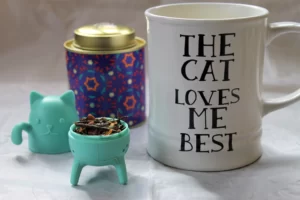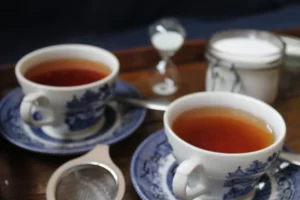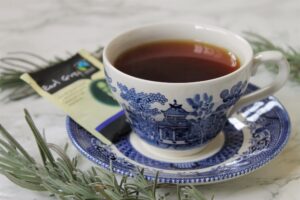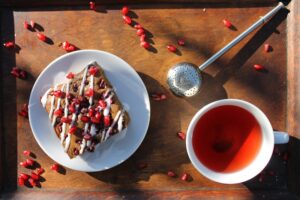I’d been into tea drinking for years before I even discovered the whole world of Eastern tea rituals and traditional tea ceremonies. Venture online and you’ll come across a whole range of new methods that are going to go straight over your head (just like they went over mine).
So, I’ve come up with a guide to the beautiful, complex ritual of the tea ceremony. Here are the basic terms and methods you’ll find, so you can understand what the tea snobs are on about and join the conversation!
What Are Eastern Tea Ceremonies? (Western vs Eastern Tea Brewing)
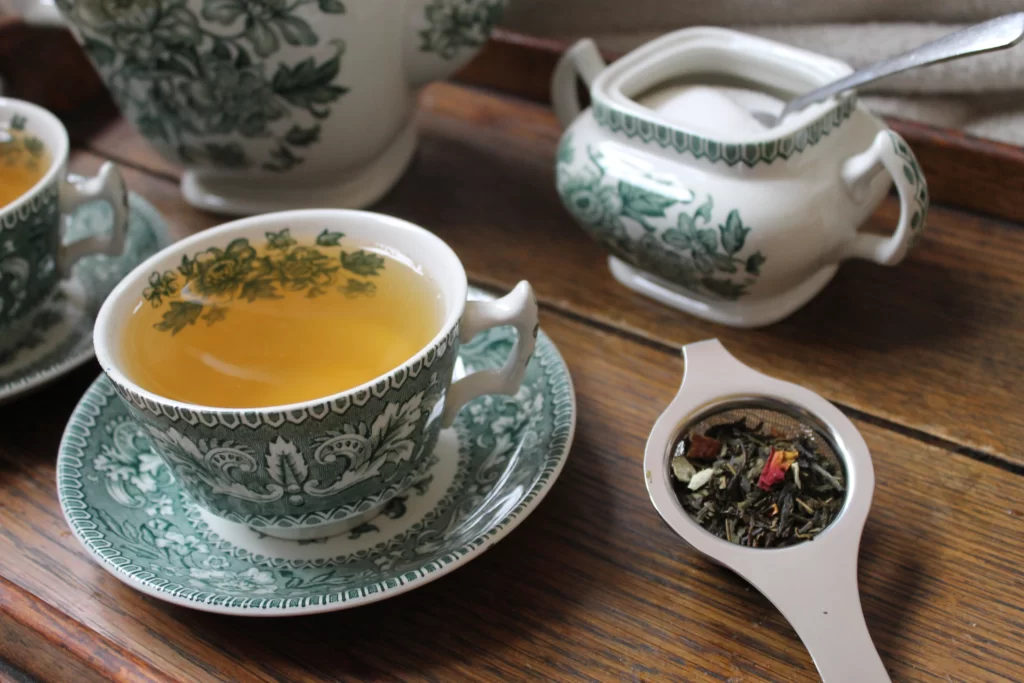
In the West, brewing tea is rarely part of a ceremony. It’s more of a ritual – offering iced tea to guests in the summer, or putting the kettle on at the same time every afternoon.
Eastern tea ceremonies are specific rituals to prepare and serve tea that are steeped in tradition. There are key steps to follow and deeper meanings behind how and why the tea is prepared. There is often a social aspect (serving tea to friends, colleagues or family) and a meditative aspect or religious element.
Beyond the traditional steps and deeper meanings, the biggest difference between Western and Eastern is the amount of tea used and the brew time.
First, ditch the tea bags. We’re dealing with loose leaf tea. I’ve already written a guide to brewing loose leaf tea in Western style, so check that out if you need to brush up your knowledge.
Western – take 2g of tea (approximately 1 teaspoon) and brew in 500ml (or a cup) of water for 2 minutes. Water temperature and brew time depend on the type of tea, but the point of this method is to brew a small amount of tea for a long time, so the cup you’re left with is infused with all the flavours from the tea.
Eastern – take 8g of tea (approximately 4 teaspoons) and brew multiple times in 200ml of water. Just like the Western tea brewing style, the water temperature depends on the type of tea. This style is about brewing a large amount of tea multiple times for very short periods (10 seconds or so). With each “brew” you’ll get a different flavour from the tea as it opens and unfurls.
That’s the basic difference, but the Eastern tea ceremony can be varied depending on where in the East it originates.
Gongfu Tea Ceremony: The Foundation of Eastern Tea Culture
A gongfu tea ceremony is where I recommend you start.
Gongfu means “making tea with skill” in Chinese and it is a traditional ceremony to serve tea in a way that allows you to better appreciate the nuances in flavour of the tea. It originated in the 18th century and is practiced today by many tea lovers around the world, as well as Chinese tea masters.
It involves using a high volume of tea leaf to water ratio, with short intense steeps rather than one very long brew. The traditional ceremony requires skill to know how long to steep the tea and truly appreciate the flavours of the brew, but with some patience and a little practice at home, you can do gongfu tea ceremonies whenever the mood strikes you.
How to Perform Simple Gongfu Tea Ceremony Steps
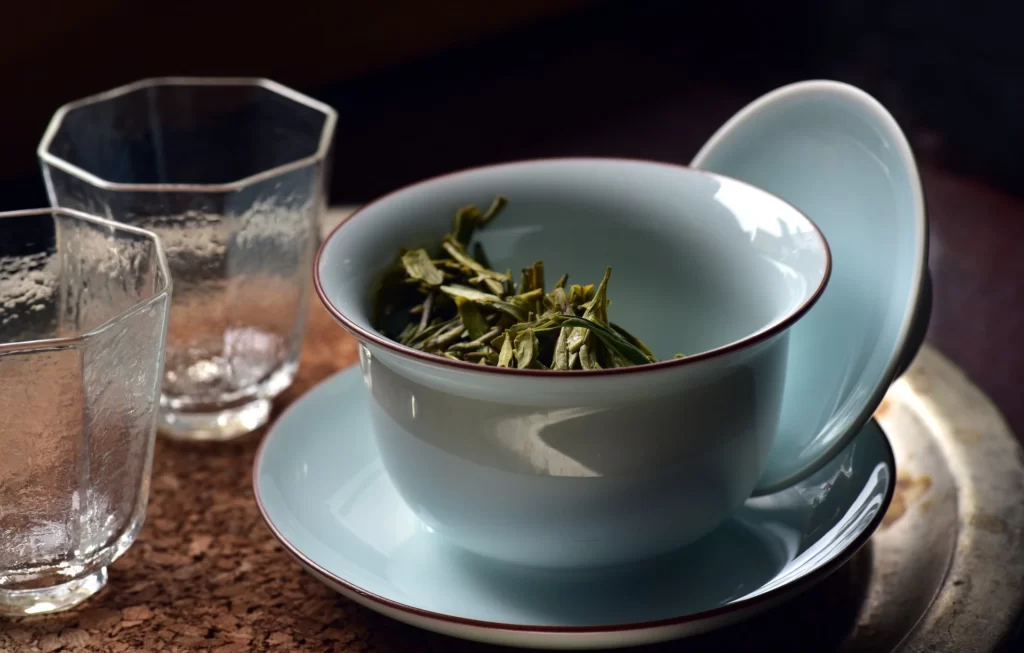
You will need: a small 200ml tea pot or Gaiwan, a fairness cup to decant into, and small cups for drinking from. I recommend this tea set, but you can make-do with a 1-cup teapot, ordinary mug for decanting, and egg cups for drinking from.
- Add 8g of tea leaves to your pot, fill with water, then discard of the water after 5 seconds (rinse).
- Fill with water again, wait 10 seconds, pour into the fairness cup. Pour from the fairness cup into each drinking cup.
- Enjoy the aroma of the tea from the pot lid.
- Sip the tea from the small drinking cup.
- Repeat steps 2 to 4, increasing the wait time by 5 seconds or until the tea seems adequately steeped and aromatic.
When you’re reading about it, the Gong Fu tea ceremony seems like a lot of steps for very little tea. Sometimes a visual example is better – so I recommend watching this explainer video by Mei Leaf for a simple Gong Fu ceremony demonstration.
What to Expect from a Gongfu Tea Ceremony
Tough question! It really depends on the tea. For example, I steeped King Tea Mall’s “Yi Wu Ma Hei” 2018 Spring Puerh Tea 10 times:
- 10 seconds: medicinal pak choi flavour and steamed veg aroma
- 15 seconds: complex cruciferous veg flavour with sweetness and strong camphor aroma.
- 15 seconds: same as above, saltier aroma.
- 20 seconds: same as above.
- 20 seconds: distinct leafy cruciferous vegetable flavour.
- 50 seconds: mellow grass with bitter flavour.
- 2 minutes, 30 seconds: unripe honeydew melon, astringent grass flavour.
- 6 minutes: green beans and unripe honeydew melon flavour, drying texture.
- 10 minutes: same as above.
- 10 minutes: same as above but weaker.
The flavours of the tea develop as the infusions grow longer, pulling different notes from the tea leaves. You won’t know exactly what journey you are in for until you get started.
Eastern Tea Ceremonies Around the World
As a beginner, it might be overwhelming to see so many different tea ceremony terms. So, let’s start with some of the most well-known tea ceremonies that you might see referenced by tea masters, shops and forums.
Chinese Tea Ceremony
Cha Doe, the traditional Chinese tea ceremony, is about enjoying your tea, savouring the aroma, flavours and relaxing. In traditional Chinese tea brewing, the tea is prepared in a clay teapot, then poured into small cups, filling them about half full – the empty half is filled with friendship (according to custom) for those you’re sharing the tea ceremony with.
From there, the traditional Chinese tea brewing often follows the gongfu method explained above. But the beauty of Cha Doe is how it appreciates the wholeness of the universe. There’s definitely a meditative element!
Further reading: Cha Doe History & Guide
Japanese Tea Ceremony
A traditional Japanese tea ceremony (The Way of Tea) is steeped in rich history and usually requires matcha style tea. This tea is becoming increasingly popular in the Western world – it’s powdered tea leaves that are whisked into water, rather than infused and removed.
For a traditional tea ceremony, everything from the clothes you wear to the way you sit in the tearoom or garden is significant. The tea server prepares the tea and pours it for the guests who enjoy as many servings as they please.
Unlike the Chinese tea ceremony and gongfu brewing in general, the powdered tea is made fresh each round as you can’t re-infuse leaves you’ve drank!
To learn more about matcha and Japanese tea ceremony steps, check out my review of the Teapro Matcha Subscription Box.
Korean Tea Ceremony
The Darye tea rite in Korea generally follows the Gong Fu style ceremony I’ve outlined above, but with differences. There are multiple types of Korean tea ceremonies you might come across. The most notable, and rather beautiful, difference I’ve seen is the representation of elements in the ceremony. Using different coloured trays and utensils, heaven, water, earth and people are all represented and honoured.
Like the Japanese ceremony, the way you act during the ceremony is as important as the tea itself.
Tea Terms and Equipment You’ll Come Across

Now you’ve got a basic idea of method, you need to understand key terms.
Gaiwan
I first came across this term on tea forums. A Gaiwan tea pot is a porcelain pot, with a lid and saucer. The porcelain absorbs some of the heat from the tea, making it ideal to brew green and white tea leaves without scorching them. You can drink directly from the Gaiwan, or decant into a cup, or use it in replacement of the pot in the Gong Fu style ceremony.
If you want to buy a gaiwan, this Zisha Red Clay Gaiwan is a reliable option. You can also find glass gaiwans and beautiful patterned gaiwans.
Fairness Cup (Cha Hai)
When you’re brewing for multiple people, you pour the tea from the pot into a fairness cup. If you poured directly into each small cup for each person one after the other, the last cup would be more infused than the first. By pouring into the fairness cup first, everyone receives the same tea liquor at the same level of infusion.
Tea Pet
A cute accessory that sits at the side of your tea ceremony. These are small clay sculptures that you douse with tea in each steep. Some will change colour, others will gradually reveal a pattern each time you douse them. Tea pets are decorative and fun.
It’s no surprise that my favourite tea pets for an Eastern tea ceremony are these cute kittens, but you can find so many different tea pets from Buddhas to fish to hippos and pandas.
Steeping Terminology
Pin Cha
Pin cha literally means “to taste tea” but it’s really more of a method. Pin cha involves brewing tea mindfully, with your heart and soul rather than just your hands. This is the meditative aspect of the Eastern tea ceremonies. During a pin cha tea session, the focus is more on the flavour of the tea and the spiritual aspects than following strict ceremonial steps.
Rinse
The first step in Eastern tea ceremonies. The first infusion, when the water hits the tea leaves for the first time, is discarded. Like you’re rinsing the tea leaves. This opens them up and gets them ready for the first real infusion.
Steep
Each time you infuse your leaves to brew more tea, that’s a “steep”. You might come across guidance for steeping some leaves, e.g. “5s rinse. Steeps: 10s, 15s, 20s, 40s, 1m…” but you can usually judge when a steep is finished by the colour or aroma of the tea. Each steep will get longer as time goes by, as the leaves release more of their flavour.
Tea Liquor
This is simply the tea liquid you brew from your tea leaves. Saying “tea” could refer to the tea leaves or the drinkable tea liquid – so it’s simply a way to differentiate.
Yixing Teapot
Yixing is a special kind of clay from China that is used to make teapots. Yixing teapots are hugely popular with serious tea drinkers as they improve the overall flavour of the tea and the tea ceremony experience. True Yixing teapots are rare – they take an extraordinary amount of time and skill to create. If you use one, you may notice a smoother and more rounded flavour in your tea – the porous texture and mineral content of the clay itself interact with the tea to create this.


